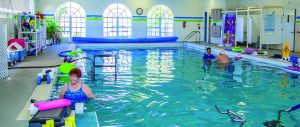 Over 1 million people in the United States have Parkinson’s Disease. It is the second most common degenerative brain disorder. It is more common in the older population, but it can occur at any age. Parkinson’s occurs due to a loss of nerve cells in a part of the brain called the substantia nigra. This results in an impairment in the movement control centers of the brain leading to primary symptoms of slowed movement, tremors, and gait and balance difficulties. It is believed that the cause of Parkinson’s is likely a combination of genetic and environmental factors. The initial symptoms can vary a lot from person to person but usually symptoms develop on 1 side of the body first. The ability to get around becomes more difficult as the disease progresses and there is a risk of falls and injury.
Over 1 million people in the United States have Parkinson’s Disease. It is the second most common degenerative brain disorder. It is more common in the older population, but it can occur at any age. Parkinson’s occurs due to a loss of nerve cells in a part of the brain called the substantia nigra. This results in an impairment in the movement control centers of the brain leading to primary symptoms of slowed movement, tremors, and gait and balance difficulties. It is believed that the cause of Parkinson’s is likely a combination of genetic and environmental factors. The initial symptoms can vary a lot from person to person but usually symptoms develop on 1 side of the body first. The ability to get around becomes more difficult as the disease progresses and there is a risk of falls and injury.
Symptoms of Parkinson’s Disease can involve slower and smaller movements, shuffling of the feet and decreased arm swing with walking, muscle stiffness and tightness, pain, forward bent posture, poor balance, the body “freezing” in place, a quieter voice, fatigue, tremors, and difficulty with normal daily activity.
Studies have shown that there can be improvements in walking, balance, strength, and flexibility in people with Parkinson’s Disease who participate in a regular exercise program. Evidence is showing that exercise that challenges the heart and lungs as well promoting posture and rhythmic movements are the best. Dancing with music can decrease stiffness. It is important to keep variety as well as movements that require balance and body adjustment. Exercises that work on attention and learning are also beneficial. Learn something new each day and challenge yourself.
A physical therapy referral can be very beneficial once a Parkinson’s diagnosis has been given. A physical therapist can develop an appropriate supervised exercise program based on an evaluation of strength, ROM, and general mobility. Physical therapy can improve balance and walking and prevent falls. An individualized program will be developed as each person’s symptoms can vary. Physical therapy can improve basic daily function and ease with getting in and out of bed or in and out of a chair. A Physical therapist can also assess the need for use of assistive devices and improve safety in daily life. There are many types of therapy programs that can be beneficial. Aquatic therapy can be helpful due to the reduced stress on the body and greater ease of movement due to buoyancy of water. Warm water can offer relaxation to tight muscles and allow for less stiffness. Balance and walking can be challenged in the water and there is less fear of falling. The LSVT BIG and Loud Programs offer evidence based standardized treatments developed for Parkinson’s Disease. It is important to make exercise fun, participate in group classes, and make exercise part of your usual day. Long term exercise habits have better outcomes. It is important for people with Parkinson’s Disease and their families to manage the symptoms, maintain fitness, and to stay as active as possible.
To find our more about how aquatic therapy can help you, please visit, www.waterworkstotalrehab.com, or call us at 239-649-2222.
Water Works Total Rehab
999 Trail Terrace Drive
Naples, FL 34103
239-649-2222
www.waterworkstotalrehab.com








